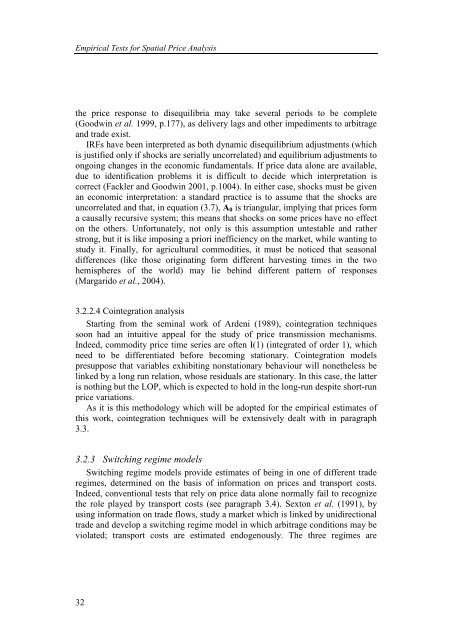TESTING INTERNATIONAL PRICE TRANSMISSION UNDER ...
TESTING INTERNATIONAL PRICE TRANSMISSION UNDER ...
TESTING INTERNATIONAL PRICE TRANSMISSION UNDER ...
Create successful ePaper yourself
Turn your PDF publications into a flip-book with our unique Google optimized e-Paper software.
Empirical Tests for Spatial Price Analysis<br />
the price response to disequilibria may take several periods to be complete<br />
(Goodwin et al. 1999, p.177), as delivery lags and other impediments to arbitrage<br />
and trade exist.<br />
IRFs have been interpreted as both dynamic disequilibrium adjustments (which<br />
is justified only if shocks are serially uncorrelated) and equilibrium adjustments to<br />
ongoing changes in the economic fundamentals. If price data alone are available,<br />
due to identification problems it is difficult to decide which interpretation is<br />
correct (Fackler and Goodwin 2001, p.1004). In either case, shocks must be given<br />
an economic interpretation: a standard practice is to assume that the shocks are<br />
uncorrelated and that, in equation (3.7), A0 is triangular, implying that prices form<br />
a causally recursive system; this means that shocks on some prices have no effect<br />
on the others. Unfortunately, not only is this assumption untestable and rather<br />
strong, but it is like imposing a priori inefficiency on the market, while wanting to<br />
study it. Finally, for agricultural commodities, it must be noticed that seasonal<br />
differences (like those originating form different harvesting times in the two<br />
hemispheres of the world) may lie behind different pattern of responses<br />
(Margarido et al., 2004).<br />
3.2.2.4 Cointegration analysis<br />
Starting from the seminal work of Ardeni (1989), cointegration techniques<br />
soon had an intuitive appeal for the study of price transmission mechanisms.<br />
Indeed, commodity price time series are often I(1) (integrated of order 1), which<br />
need to be differentiated before becoming stationary. Cointegration models<br />
presuppose that variables exhibiting nonstationary behaviour will nonetheless be<br />
linked by a long run relation, whose residuals are stationary. In this case, the latter<br />
is nothing but the LOP, which is expected to hold in the long-run despite short-run<br />
price variations.<br />
As it is this methodology which will be adopted for the empirical estimates of<br />
this work, cointegration techniques will be extensively dealt with in paragraph<br />
3.3.<br />
3.2.3 Switching regime models<br />
Switching regime models provide estimates of being in one of different trade<br />
regimes, determined on the basis of information on prices and transport costs.<br />
Indeed, conventional tests that rely on price data alone normally fail to recognize<br />
the role played by transport costs (see paragraph 3.4). Sexton et al. (1991), by<br />
using information on trade flows, study a market which is linked by unidirectional<br />
trade and develop a switching regime model in which arbitrage conditions may be<br />
violated; transport costs are estimated endogenously. The three regimes are<br />
32
















